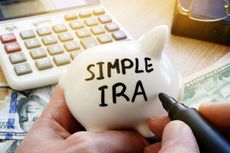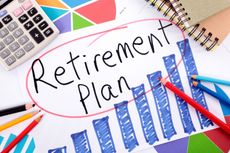Save for Now -- and for Later
With a fat emergency fund, this high school teacher can also afford to start a Roth IRA.
OUR READER
Emeka Diribe, 27
Fullerton, Cal.

Sign up for Kiplinger’s Free E-Newsletters
Profit and prosper with the best of expert advice on investing, taxes, retirement, personal finance and more - straight to your e-mail.
Profit and prosper with the best of expert advice - straight to your e-mail.
Should I build my emergency fund or invest more for retirement?
When the economy began to unravel, Emeka decided he needed to save more. His goal: to sock away cash in case something happened to his job (he's a high school math teacher). So Emeka started an emergency fund and has built up a stash equal to six months' worth of expenses in an online savings account with ING Direct. Meanwhile, Emeka, who is single, is accruing retirement benefits in the California teachers' retirement system. But now, as he looks at his savings -- which also include several thousand dollars in stocks -- he's wondering whether he's doing enough. "I'm trying to find the right mix," he says.
About 20,000 teachers were laid off in California last year, and Emeka wants to squirrel away as much as he can. Should he bulk up his emergency-fund savings to cover a year's worth of expenses? He could open an IRA, but he says he doesn't like the idea of tying up his money. And he'd like to have money to buy a house someday.
Emeka is off to a good start. If the past two years have taught us anything, it's the importance of having financial reserves and living within our means. He chose well by putting his savings in an ING account. ING has no maintenance or withdrawal fees, and it pays 1.3% interest, which is higher than the rate the average money fund pays.
But does someone who is young and single need an enormous emergency fund? Teaching may not be a lucrative occupation, but it's more secure than most jobs. Emeka should think about two issues: how long it would take to find a new position if he needed to, and whether he would feel more secure with a bigger buffer.
Usually, being able to cover three to six months' worth of expenses is sufficient. But with jobs hard to come by, a larger stash makes sense. "If he has a year's worth of savings and he loses his job, he won't have to take the first offer that comes along," says Michael Eisenberg, of Eisenberg Financial Advisors, in Los Angeles. (See "How Much Cash You Really Need".)
FOCUS ON RETIREMENT
Once Emeka fattens his fallback fund, he should concentrate on retirement savings. He'd benefit from opening a Roth IRA, to which he can contribute $5,000 in 2010. His money will grow tax-free, and he can withdraw his contributions without a penalty if he needs the money before retirement. Plus, having a Roth will diversify his retirement savings.
Herb Montgomery, a financial planner in Orleans, Mass., uses the following example. Two friends, Jeff and Susan, join the same firm at age 22. Both aspire to retire in 40 years. Susan immediately opens a Roth IRA, contributes $5,000 a year for ten years, and stops. Jeff waits until he's 32 to open a Roth, but then invests $5,000 a year for 30 years. Assuming an 8% annual return, at retirement Susan would have $787,000, and Jeff would have $612,000. Susan's head start is worth that much. The lesson for Emeka: The benefits of tax-deferred savings outweigh the chance he'll be sacked from the classroom.
-
 What Happens Financially When You Work One More Year?
What Happens Financially When You Work One More Year?The impact of saving more, spending less later and benefiting from an extra year or more of compounding can be truly staggering.
By Andrew Rosen, CFP®, CEP Published
-
 Seven Ways to Spend Your Tax Refund
Seven Ways to Spend Your Tax RefundYou may want to splurge, but using your tax refund to save for the future or pay down debt is a much better idea — even if not as fun.
By Kathryn Pomroy Published
-
 403(b) Contribution Limits for 2024
403(b) Contribution Limits for 2024retirement plans Teachers and nonprofit workers can contribute more to a 403(b) retirement plan in 2024 than they could in 2023.
By Jackie Stewart Published
-
 SEP IRA Contribution Limits for 2024
SEP IRA Contribution Limits for 2024SEP IRA A good option for small business owners, SEP IRAs allow individual annual contributions of as much as $69,000 a year.
By Jackie Stewart Published
-
 Roth IRA Contribution Limits for 2024
Roth IRA Contribution Limits for 2024Roth IRAs Roth IRA contribution limits have gone up for 2024. Here's what you need to know.
By Jackie Stewart Published
-
 SIMPLE IRA Contribution Limits for 2024
SIMPLE IRA Contribution Limits for 2024simple IRA The maximum amount workers at small businesses can contribute to a SIMPLE IRA increased by $500 for 2024.
By Jackie Stewart Published
-
 457 Contribution Limits for 2024
457 Contribution Limits for 2024retirement plans State and local government workers can contribute more to their 457 plans in 2024 than in 2023.
By Jackie Stewart Published
-
 Roth 401(k) Contribution Limits for 2024
Roth 401(k) Contribution Limits for 2024retirement plans The Roth 401(k) contribution limit for 2024 is increasing, and workers who are 50 and older can save even more.
By Jackie Stewart Published
-
 Is a Medicare Advantage Plan Right for You?
Is a Medicare Advantage Plan Right for You?Medicare Advantage plans can provide additional benefits beneficiaries can't get through original Medicare for no or a low monthly premium. But there are downsides to this insurance too.
By Jackie Stewart Published
-
 What You Must Know About the Different Parts of Medicare
What You Must Know About the Different Parts of MedicareMedicare Medicare can be complicated but we've got you covered. Here is a quick guide to the different benefits provided through each part.
By Jackie Stewart Last updated